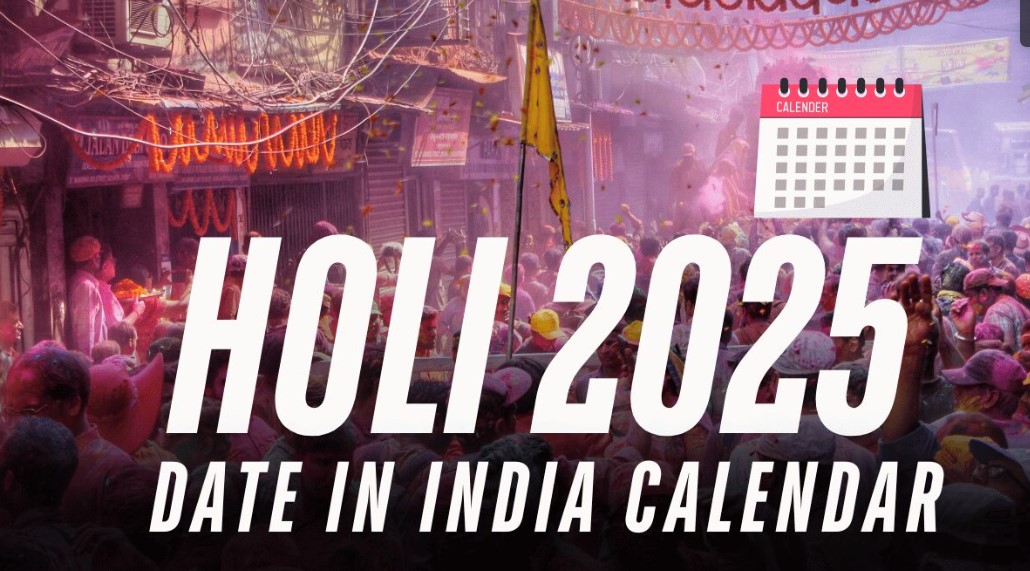Holi 2025 date in India calendar

Holi, the festival of colors, is one of the most joyous and vibrant festivals celebrated in India. It signifies the arrival of spring, the victory of good over evil, and is an occasion for people to come together, forgetting past grievances. In 2025, Holi will be celebrated on March 14 (Thursday), with Holika Dahan, the pre-Holi ritual, taking place on March 13 (Wednesday).
Holi 2025 Date in India Calendar
The date of Holi is determined by the Hindu lunar calendar and falls on the full moon day (Purnima) of the Hindu month of Phalguna. In 2025, the full moon will occur on March 13-14, making March 14 the main day of Holi festivities.
- Holika Dahan (Chhoti Holi) – March 13, 2025 (Wednesday)
- Rangwali Holi (Main Holi Celebration) – March 14, 2025 (Thursday)
Significance of Holi
Holi is deeply rooted in Hindu mythology and history. It represents the triumph of good over evil and is associated with various legends. The most well-known stories related to Holi are:
1. Legend of Prahlad and Holika
One of the most famous legends associated with Holi is the story of Prahlad, Hiranyakashipu, and Holika. Hiranyakashipu, a demon king, wanted everyone to worship him instead of the gods. However, his son Prahlad was a devoted follower of Lord Vishnu. Angered by his son’s devotion, Hiranyakashipu sought to kill Prahlad.
He enlisted the help of his sister Holika, who had a boon that made her immune to fire. She sat in a fire with Prahlad on her lap, hoping to burn him alive. However, due to divine intervention, Holika perished while Prahlad remained unharmed. This event symbolizes the victory of devotion and righteousness over arrogance and evil, and Holika Dahan is celebrated to commemorate this victory.
2. The Divine Love of Radha and Krishna
Holi is also linked to Lord Krishna and Radha’s love story. According to mythology, young Krishna, who had a dark complexion, was insecure about whether Radha, with her fair skin, would accept him. His mother, Yashoda, playfully suggested that he could color Radha’s face with any hue he liked. This playful act became a tradition and is one of the reasons why colors are an essential part of Holi celebrations.
3. The Return of Spring
Holi marks the transition from winter to spring, symbolizing renewal and happiness. Farmers celebrate the festival as a harvest festival, expressing gratitude for a good crop and welcoming prosperity.
Holi Celebrations Across India
Holi is celebrated with great enthusiasm across India, with regional variations that add to its charm. The common tradition involves people smearing each other with gulal (colored powder), splashing water, singing, dancing, and enjoying festive delicacies.
1. Lathmar Holi in Barsana and Nandgaon
In Barsana (Uttar Pradesh), Holi is celebrated uniquely as Lathmar Holi, where women playfully beat men with sticks. This tradition is inspired by the legend of Radha and Krishna and is a major attraction for tourists.
2. Holi in Mathura and Vrindavan
Mathura and Vrindavan, associated with Lord Krishna, host grand Holi celebrations. The Braj Holi festival lasts for over a week and includes Phoolon Ki Holi (Holi with flowers), Widow’s Holi, and traditional temple rituals.
3. Shantiniketan Basanta Utsav (West Bengal)
In West Bengal, Basanta Utsav (Spring Festival) is celebrated in Shantiniketan, founded by Rabindranath Tagore. Here, Holi is observed with cultural performances, music, dance, and poetry readings.
4. Hola Mohalla (Punjab)
In Punjab, Hola Mohalla is celebrated by Sikhs, combining Holi with martial arts demonstrations, horse riding, and mock battles. It is an occasion for bravery, community spirit, and religious devotion.
5. Royal Holi in Rajasthan
Rajasthan hosts an extravagant Holi celebration, with royal families organizing grand events featuring elephants, folk dances, and processions. Udaipur and Jaipur are especially famous for their regal Holi festivities.
Holi Celebrations Outside India
Holi is not just confined to India; it is celebrated worldwide in countries with a significant Indian diaspora. Places like Nepal, the USA, the UK, Canada, Mauritius, South Africa, and Australia host grand Holi events, bringing people together through colors, music, and dance.
Holi Special Foods
Holi is incomplete without its delicious treats. Some of the most popular Holi-special delicacies include:
- Gujiya – A deep-fried pastry filled with sweet khoya and dry fruits.
- Thandai – A refreshing milk-based drink with nuts, saffron, and spices.
- Malpua – A sweet pancake dipped in sugar syrup.
- Dahi Bhalla – Soft lentil dumplings soaked in yogurt and topped with chutneys.
- Puran Poli – A sweet flatbread made with jaggery and lentils.
Precautions for a Safe and Eco-Friendly Holi
While Holi is a fun-filled festival, it’s essential to celebrate it responsibly:
1. Use Organic Colors
Chemical-based colors can cause skin and eye irritation. Opt for organic or homemade colors made from flowers, turmeric, and natural dyes.
2. Protect Your Skin and Hair
Apply coconut oil or moisturizer on your skin and hair before playing Holi to prevent damage from colors.
3. Avoid Wastage of Water
Holi is traditionally a dry festival, and excessive use of water can lead to wastage. Try celebrating with dry colors or flower petals instead.
4. Be Mindful of Animals
Many animals suffer due to harmful colors. Avoid throwing colors on pets and stray animals.
5. Play Safe
Respect others’ boundaries and avoid forcefully applying colors on those who do not wish to participate.